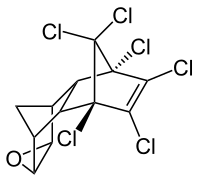Endrin facts for kids
Quick facts for kids Endrin |
|
|---|---|
 |
|
 |
|
| IUPAC name | (1R,2S,3R,6S,7R,8S,9S,11R)-3,4,5,6,13,13-Hexachloro-10-oxapentacyclo[6.3.1.13,6.02,7.09,11]tridec-4-ene |
| Other names | Mendrin, Compound 269, (1aR,2S,2aS,3S,6R,6aR,7R,7aS)-3,4,5,6,9,9-hexachloro-1a,2,2a,3,6,6a,7,7a-octahydro-2,7:3,6-dimethanonaphtho[2,3-b]oxirene, 1,2,3,4,10,10-Hexachloro-6,7-epoxy-1,4,4a,5,6,7,8,8a-octahydro-1,4-endo,endo-5,8-dimethanonaphthalene |
| Identifiers | |
| CAS number | |
| PubChem | |
| KEGG | C18124 |
| ChEBI | CHEBI:81526 |
| RTECS number | IO1575000 |
| SMILES | C1C2C3C(C1C4C2O4)C5(C(=C(C3(C5(Cl)Cl)Cl)Cl)Cl)Cl |
|
InChI
InChI=1/C12H8Cl6O/c13-8-9(14)11(16)5-3-1-2(6-7(3)19-6)4(5)10(8,15)12(11,17)18/h2-7H,1H2/t2-,3+,4+,5-,6-,7+,10-,11+
|
|
| Properties | |
| Molecular formula | |
| Molar mass | 0 g mol-1 |
| Appearance | Colorless to tan crystalline solid |
| Density | 1.77 g/cm3 |
| Melting point | |
| 0.23 mg/L | |
| Vapor pressure | 2.6 x 10-5 Pa |
| Hazards | |
| NFPA 704 |
|
| Flash point | noncombustible |
| U.S. Permissible exposure limit (PEL) |
TWA 0.1 mg/m3 [skin] |
| Except where noted otherwise, data are given for materials in their standard state (at 25 °C, 100 kPa) | |
Endrin is a powerful chemical that was once used to kill insects and rodents. It was very common for farmers who grew cotton and cereal crops. This chemical is a neurotoxin, which means it can harm the nervous system of living things.
Endrin is very similar to another chemical called Dieldrin. They are like mirror images of each other, which is what a stereoisomer means in chemistry.
Contents
Why Endrin is Harmful
Endrin is a very dangerous chemical. It can stay in the soil for a very long time, sometimes up to twelve years, before it breaks down. This means it can keep harming the environment and animals for many years.
Impact on Living Things
Because Endrin is a neurotoxin, it can be very harmful to animals and humans. Even small amounts can cause serious health problems. It can affect the brain and nerves, leading to sickness.
Environmental Concerns
When Endrin stays in the environment, it can pollute the soil and water. This pollution can then affect plants, animals, and even people who come into contact with it. Its long-lasting nature makes it a persistent organic pollutant.
Global Ban on Endrin
Because of how dangerous Endrin is, countries around the world decided to ban it.
The Stockholm Convention
Endrin is one of twelve chemicals listed in the Stockholm Convention on Persistent Organic Pollutants. This is an international agreement that aims to protect human health and the environment from chemicals that stay in the environment for a long time and can travel far.
When it was Banned
Since 2004, the production, trade, and use of Endrin have been completely banned in many countries. This ban helps to prevent more harm to people and the planet.
See also

- In Spanish: Endrina (plaguicida) para niños


